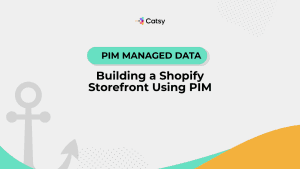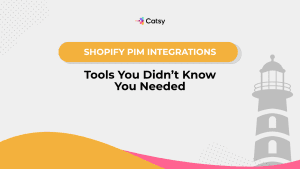PIM vs Shopify Metafields: When to Use Each
Learn the difference between PIM and Shopify metafields. Discover when to use each and how Catsy helps scale product data management for your Shopify store.

Table of Contents
- Introduction
- What Are Shopify Metafields?
- What Is a PIM System?
- PIM vs Shopify Metafields: A Side-by-Side Comparison
- When Metafields Are Enough
- When You Need a Full PIM
- How Catsy Bridges the Gap
- Conclusion
What You Will Learn
- The difference between Shopify metafields and a PIM system
- When metafields can handle your product data needs
- Where metafields fall short, and how PIM fills the gap
- How to scale catalog complexity with a structured PIM data model
- How Catsy offers a smoother journey from manual to mature data management
In this Article
1. Introduction
If you’re navigating Shopify’s backend, you may feel like you’re piloting a ship through a storm. On the surface, everything looks smooth. But underneath, your unmanaged product data can drift into disarray.
Liken Shopify meta fields to short-range radar. They’re useful, but they don’t provide a full picture. A PIM, on the other hand, can be your entire navigational suite! Product information management systems are ready to handle stormy seas and long voyages.
In this guide, we’re going to break down PIM vs Shopify Metafields, helping you understand when native Shopify features suffice and when it’s time to upgrade to a robust Product Information Management system like Catsy.
2. What Are Shopify Metafields?
Shopify metafields are custom fields that let you (the merchant) add extra information to products, collections, orders, customers, and more. Think of them as extensions to Shopify’s default schema.
a. Purpose and Use Cases
Need examples? With metafields, you can:
- Add care instructions to apparel
- Display tech specs for electronics
- Attach materials and compliance data to business-to-business SKUs
- Control front-end display logic on product templates
Shopify offers both built-in and custom metafields, which are accessible via the admin UI or API. They’re flexible and work well for simple to moderately complex use cases.
b. Limitations of Shopify Metafields
Shopify metafields are useful, but they do carry drawbacks if you’re using them for large or complex catalogs.
- No centralized control across products
- Difficult to reuse logic or rules across categories
- No validation…any backend user can input inconsistent or incorrect data
- Limited ability to manage digital assets or multi-language content
- No built-in data governance or automation workflows
- Not ideal for managing catalog content at scale
According to Shopify, metafields are designed for “extending store data – not managing full catalogs.”
Source: Shopify Dev Docs
Complex catalogs are the metaphorical fog on our sea. A more powerful system is needed.
Make Catsy DAM and PIM Software an Extension of Your Team
Book a Free Demo3. What Is a PIM System?
A PIM is a centralized hub for managing product data across systems, teams, and channels. Metafields only exist within Shopify, but a PIM provides a source of truth.
a. The PIM Data Model Explained
A PIM platform structures your catalog around certain criteria, including families, attributes, channels, and locales. A mature PIM data model supports:
- Parent-child relationships (products and variants)
- Attribute sets per category or locale
- Channel-specific pricing, descriptions, and media
- Version control and approval workflows
- Asset management and localization tools
PIM tools like Catsy are purpose-built for mastering product catalog management at scale.
b. Use Cases for PIM
- Managing over 1000 SKUs with shared and unique attributes
- Coordinating product launches across Shopify, Amazon, and business-to-business portals
- Automating bulk updates and validations
- Creating localized content in multiple languages
- Assigning tasks to copywriters, designers, and SEO teams
Your PIM is like the bridge crew of your e-commerce ship. Your data stays coordinated, specialized, and in sync.
4. PIM vs Shopify Metafields: A Side-by-Side Comparison
Let’s compare these two tools in the areas that matter most for growing e-commerce teams:
a. Data Structure & Flexibility
Feature | Shopify Metafields | PIM (e.g., Catsy) |
Attribute Types | Limited | Highly customizable |
Validation Rules | None | Enforced at scale |
Multi-level Product Hierarchy | No | Yes (families, variants) |
Asset Linking | Basic | Central DAM integration |
b. Scale and Automation
Feature | Shopify Metafields | PIM (e.g., Catsy) |
Bulk Updates | Manual via CSV | Automated via workflows |
Version Control | No | Yes |
Change History | Limited | Full audit trails |
c. Multichannel Distribution
Feature | Shopify Metafields | PIM (e.g., Catsy) |
Channels Supported | Shopify only | Shopify, Amazon, B2B, etc. |
Locale Support | Basic | Advanced translation/localization tools |
d. Collaboration and Governance
Feature | Shopify Metafields | PIM (e.g., Catsy) |
Role-Based Access | No | Yes |
Task Management | No | Yes |
Approval Workflows | No | Yes |
5. When Metafields Are Enough
Scenarios absolutely exist where Shopify meta fields are perfectly sufficient. These may include:
- You have fewer than100 products
- Only one person manages your product content
- You don’t sell across multiple regions or channels
- Your product content is relatively static
- You don’t need collaborative workflows
If your Shopify store is a small sailboat with a short route and minimal crew, metafields can steer the ship without issue.
6. When You Need a Full PIM
As your catalog grows, your meta fields begin to show their cracks. It’s time for a PIM when:
- You’re duplicating data across products manually
- You spend hours updating specs or SEO tags
- Different team members are working with outdated content
- You plan to sell on Amazon, Walmart, or through distributors
- You want to improve your product data quality and governance
These benefits translate into real efficiency gains and fewer surprises at sea.
7. How Catsy Bridges the Gap
Catsy was built to help you graduate from meta fields – without losing your flexibility. The PIM plugs directly into Shopify and provides all the tools that are missing from native metafield options. These include:
- Visual product content previews
- Attribute mapping to Shopify fields or metafields
- Multi-store localization
- Bulk updates and real-time sync
- DAM integration for media and PDFs
- Validation rules to prevent bad data from going live
With Catsy, you’re not just patching holes! You’re upgrading to a fully-rigged e-commerce vessel.
8. Conclusion
Shopify metafields are helpful, lightweight tools for merchants in the early stages of their e-commerce journey. But as your catalog complexity grows, your ability to manage it through metafields alone will feel like bailing water with a teaspoon.
A dedicated PIM like Catsy will provide the infrastructure, scale, and governance you need to manage your product data efficiently and accurately. Your team can collaborate with fewer errors and data silos.
If you’re navigating a growing catalog or expanding to multichannel selling, now’s the time to raise the sails… let a PIM steer your product content forward.
9. Key Takeaways
- Shopify metafields extend product data but lack scalability
- PIM systems offer structured, governed, and collaborative data management
- PIMs support bulk editing, validation, digital assets, and localization
- Use metafields for simple catalogs; use PIM for complex, multichannel growth
- Catsy bridges Shopify’s limitations with a robust PIM + DAM solution
Want more tips, tutorials, and insights on product content and e-commerce operations?
Stay connected. We post regularly to help brands like yours scale smarter.
Are You Ready To streamline your product content management?
Continue Reading

10. Frequently Asked Questions
Yes. Catsy can map your PIM-managed attributes directly to Shopify metafields for seamless integration.
Risks include lack of validation, no collaboration tools, manual workflows, and poor scalability. These can lead to inconsistent product data and missed opportunities.
Catsy offers import tools and onboarding support to migrate and normalize your existing product data for a clean transition.
Absolutely! Catsy has built-in DAM functionality, allowing you to link images, videos, documents, and 3D assets to product records. Learn more about PIM vs DAM.
Stores with over 100 SKUs, multiple variants, complex attributes, or multichannel/multilingual needs will see the most benefit.
Subscribe For More Content
Sign up for monthly tips on how to drive revenue with product content.




